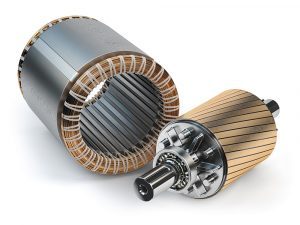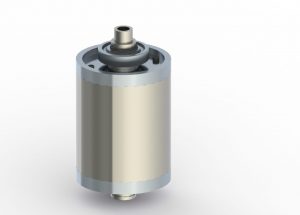An industry in changeover
Mobility is in a state of changeover, thus demanding innovative concepts. In the process,
e-mobility is increasingly gaining in significance. According to the Federal Motor Transport Authority (KBA), around 194,000 passenger motor cars with pure battery electricity were registered in 2020. This is equivalent to an increase of 206 per cent compared to 2019. This is not only attributable to the fact that electric mobility is increasingly inspiring more human beings. In the meantime, vehicles are also more technically sophisticated, more comfortable, silent and they have increasingly larger driving ranges. Moreover, an electric motor car requires less maintenance than a petrol or diesel vehicle. In addition, the increase in the use of renewable energy sources is ensuring that the environmental balance of the electric drive is improving constantly and continuously.
Content
Electric motor – the drive of the future

The various drive technologies

Stator and rotor of an electric motor.
The electric drive is the drive of the future. It converts electrical energy to mechanical energy with the help of electricity. To put it simply, this comprises only a pair of solenoids, copper and a shaft for transmission of force – compared with a modern petrol engine, far fewer components are installed. This has considerable impact on the suppliers in the automotive industry. The mechanical engineers must switch to the new technologies that the vehicles need in the future.
Currently, there are four drive technologies in e-mobility:
The separately excited synchronous motor:
With this version of the motor, apart from the stator magnetic field, the magnetic field of the rotor is also generated by a solenoid. In this way, no rare-earth magnets are used, which are very expensive and finite in their availability. Energy transmission generally takes place with the help of a slip-ring system on the rotor.
The permanent-magnet synchronous motor
With this drive variant, there are so-called permanent magnets located in the rotor, which generate a magnetic field. This magnetic field tracks the rotating magnetic field in the stator with the same speed – similar to two gear wheels that engage with one another. This principle of operation makes the synchronous motor particularly efficient and powerful. However, powerful magnets of rare-earth elements such as neodymium are installed. As a result of this, production is expensive.
The asynchronous motor
In this drive, the somewhat faster rotating stator magnetic field generates a flow of current in the conductor rods of the rotor, which, in turn, generates a magnetic field in the rotor. In this way, the stator magnetic field is able to make the rotor turn along with the magnetic field.
Depending on the design, the conductor rods in the rotor may be made from aluminium or copper.
Since the speed of the stator magnetic field is not equal to the rotor speed, you talk of an asynchronous motor. With the stator voltage switched off, there is no magnetic field present in the entire system and the motor can be rotated with very low level of power loss. This type of operation is particularly attractive and interesting for cars with multiple drive motors.
The reluctance motor
Reluctance motors are considered as an alternative in the field of electric drives. The motors are compact and do not require any rare earth elements. The reluctance motor utilises the phenomenon that every system strives for minimum magnetic resistance (reluctance). Since the rotor manages without a permanent magnet or electromagnet, it is very low in cost to produce. However, it is loud and less smooth in operation.
The drive that will prevail and whether other variants get added to this list depends largely on the development of the battery and energy prices.
Energy-related matters
At present, the cost driver in electric mobility is the battery. Nonetheless, this will change in the future. The lithium-ion rechargeable batteries installed in electric cars are not only heavy at present, but also contain expensive materials such as lithium as the charge carrier as well as nickel, manganese and cobalt for the electrodes – and these in large quantities. However, it is expected that lithium-ion rechargeable batteries will become increasingly more efficient and thus, also more compact. If a rechargeable battery weights, for example, 500 kilograms today, the weight can be considerably lower in a few years from now with continuous development. Despite more compact dimensions, batteries will become increasingly more powerful. At the same time, manufacturers in the E-mobility sector are continuously pursuing the development of alternatives, such as hydrogen technology.
What changes for suppliers with electric mobility?

The rotor: one of the few components in the electric motor.
Numerous suppliers of pistons, turbo chargers or gearboxes, in other words, of components that are used in classical automotive engineering, have identified this trend and hence, they are moving in a new direction towards e-mobility. Since an electric motor contains fewer components than that of a petrol or diesel drive, the production chains undergo change. Automated processes will increase and the number of work steps may possibly reduce under certain circumstances. In order to be able to respond quickly in the market, companies from the supplier industry, in particular, require strong partners on their side.
How does Sonplas support suppliers along the path towards e-mobility?
We are aware of the OEMs and suppliers in classical automotive engineering and in electric mobility. As a holistic services provider, we support our customers with tailored and turnkey system solutions. These are perfectly suitable for development and series production of technical components and products. With the help of our in-house research and development department, we are able to constantly meet the latest technical requirements in the market. 
What are the challenges confronting suppliers in the e-mobility sector?
The development cycles for the e-mobility-related products are becoming increasingly shorter. This is why suppliers require systems with the help of which they can manufacture new products quickly – and are still flexible for this purpose. We have flexible concepts, with the help of which, for example, various rotor versions or variants can be produced on one line. This is how you save time and money. We take you by your hand and support you with our Research & Development. In addition, we verify the theory behind your process concepts and make sure that they work in practice.
With a deep understanding of electric mobility, we not only help you in optimising your processes but also in launching your products more cost-effectively in the market. We can also offer alternative solutions if required. Moreover, we can support you in reducing your manufacturing costs. In plain text: As a holistic services provider, we think along the same lines and always get involved specifically with your requirements.
What makes Sonplas stand out
We always think in terms of the system. This is why – in complex projects – we work very closely with our partners. Depending on the particular task, these can be, among others, robot suppliers or even manufacturers of laser equipment and technology. As a general contractor, we not only implement individual processes, but also entire production lines for our customers. We are not only aware of the product but the entire system architecture. Together with our customers, we were able execute and implement exciting projects worldwide in the past, and support them comprehensively with our globally distributed service partners.
How Sonplas can implement several projects for different customers
We can not only serve one customer, but we even execute multiple projects simultaneously. For this purpose, we have extensive know-how in-house that is distributed across various personnel in our workforce. We form a separate project team for every order. In this way, you always have only one contact person.
Our assembly concepts can be applied with customisation for various customers. They use both proven technologies as well as solutions that we develop jointly with you. In order to know how electric mobility concerns us, we constantly remain in touch with whatever is currently happening in the market.
How Sonplas supports customers in building prototypes
The construction of prototypes indicate the direction in which trends will be moving. For every prototype, you have to determine the certainty of mass manufacture and optimise processes in order to be able to cover the customer’s demands. However, several suppliers do not have the necessary equipment to build prototypes such as those of rotors or inverters. This is where we support you as a holistic services provider with the necessary systems, solutions and comprehensive know-how.
Our
FAQs
Here you can find our answers to frequently asked questions.
There are processes, which are similar for assembly and testing of components in classical drives as those in electric mobility. However, they cannot be taken over one-to-one and have to be adapted suitably.
We offer suitable concepts with the help of which different types of items like a rotor or inverter can be assembled. The number of different types that are produced on a production line is generally a matter of economic viability.
One approach is somewhat the one-piece flow technology combined with change on the fly: In the process, assembly takes place manually or by automatically linked systems in accordance with a specified work-flow.
With the help of automatic control of the work-flow and automatic changeover of stations, you can set up production lines that are capable of manufacturing two or more products in parallel. The multi-utilisation of existing stations and enhancing the number of pieces on a production line facilitates considerable reduction in production costs per part with proper design and, in this way, a definitive competitive edge for our customers.
The hybrid drive is characterised, on the one hand, by low fuel consumption and, on the other, by better acceleration. Since an electric motor is also installed, a smaller combustion engine with less power and thus, lower consumption is adequate. If excess energy is available, the electric motor becomes an electric generator and charges the battery.
The purely electric drive offers certain advantages compared to commercially available types of drives. Apart from lower operational costs, among others, the efficiency of the motor is higher: the installed motors have an efficiency of up to 90 per cent.
In addition, the E-motor does not generate any CO2 emissions and makes its contribution in this way to achieving climate goals. Moreover, even the noise emissions of these types of drives are lower making driving comfortably quiet.
Whether you now need assembly and testing systems for pure e-mobility in the high-voltage range at 400 and 800 Volts or for a 48 Volt system for the hybrid technology, we can support you as a holistic services provider with customised systems right up to complete production lines. Here, you can benefit from our extensive experience. We are at home in both sectors.